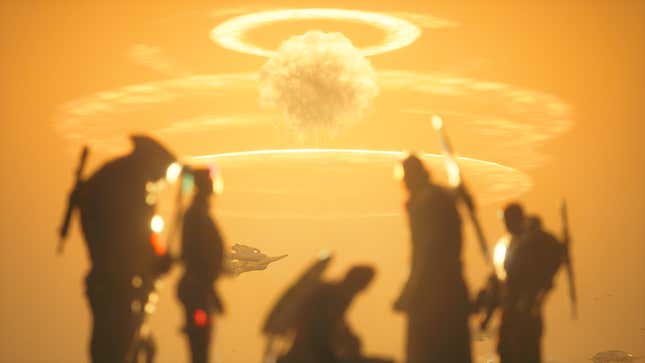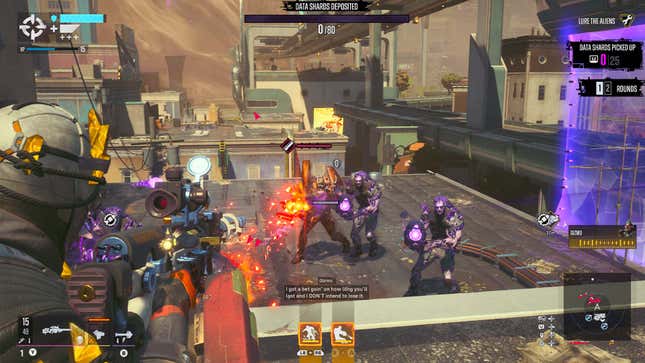After years of trailers, delays, controversy, and leaks, Rocksteady’s big, live-service, open-world, villain-themed, DC third-person looter shooter—Suicide Squad: Kill The Justice League—is finally out (for real). The narrative that has formed around this game over the last few years has grown as large and epic as a superhero movie. Some folks want Suicide Squad to crash and burn. Others want it to succeed, hoping Rocksteady has built something amazing, a game worth their money and time. Sadly, as with many modern superhero films, the ending to this saga is anticlimactic and won’t appease either folks hungry for blood or hopeful for fun. Instead, what we have here is something decidedly middle-of-the-road.
Suicide Squad: Kill The Justice League is not only developed by Rocksteady, the makers of the popular Arkham games, but also set in that same universe. The game takes place a few years after the end of Arkham Knight. Batman faked his death, joined up with the Justice League, and headed over to Metropolis to be super pals with Wonder Woman, Superman, Flash, and Green Lantern. Things were going well, until Brainiac and his alien minions arrived, mind-controlled all of them—except Wonder Woman—and turned the powerful heroes against their own planet. Now, it’s up to Harley Quinn, Captain Boomerang, King Shark, and Deadshot—DC supervillains with bombs implanted in their heads—to save the world by, well, as the game’s name implies, killing the Justice League.
While the Suicide Squad’s story never truly surprised me or broke any new ground in the superhero genre, it’s still a well-written comic book adventure with enough twists and turns to keep you hooked. It also helps that every character in the game, even those barely involved in the action, are fleshed out, with their own goals, flaws, personalities, and feelings.
As you might expect, Harley, Deadshot, King Shark, and Boomerang get the biggest spotlight. Rocksteady has done a fantastic job not just visually capturing these characters with some of the best-looking faces I’ve seen this generation, but also making them feel distinct. Each character in the squad also has their own arc and they all intertwine throughout the game so that by the end I was totally on board with these loser misfits coming together to save the day. It also helps that their dialogue—both in the game’s gorgeous cutscenes and out in the open world during gameplay—is peppered with solid jokes and genuine moments of reflection and growth.
But boy howdy, is this game talkative! I lost count of the number of times when up to three different conversations were happening all at once, sometimes overlapping each other or completely blocking out important or interesting lore. To the game’s credit, I didn’t hear many repeated chats, but sadly, I also missed a lot of stuff because while the squad was chatting about one thing, I’d shoot a drone and trigger a conversation about something else, ending the one that was already happening. Still, even overlapping dialogue isn’t too bad. What is bad is almost everything else between the dialogue and cutscenes.
Over and over and over…
Suicide Squad’s main campaign features a strong and impressive intro that quickly establishes the “heroes,” explains how the team’s boss—Amanda Waller—controls them, and sets up the stakes of the invasion. This confident and perfectly paced first few hours instantly won me over. However, once the game opens up more and lets you loose in its digital city, things quickly go downhill. Do you like guarding locations, shooting crystals, or saving people? Well, I hope so, because that’s basically all this game is outside of the intro and a few boss fights.
The structure of Suicide Squad goes like this: You watch a cool cutscene, learn what the next step is in the plan to save the world, and then do a type of mission that you’ve already done before but maybe in a new location or with some new enemies. Maybe. Repeat that for about 15 to 20 hours depending on how much of the game’s side content you check out. (Though, be warned, all the side content in this game beyond Riddler challenges are the same types of missions you do in the main campaign.)
It’s a credit to Suicide Squad’s fantastic and satisfying combat that during most of these missions, I wasn’t bored out of my mind. But I’d be lying if I said I was having fun guarding the same plants or destroying the same crystals over and over and over again. At one point, I was tasked with escorting a slow-moving vehicle through a dangerous area. Normally, escort missions aren’t anything to celebrate, but it was a completely new type of mission, after 10 hours of play. I was pumped! And then that same type of mission popped back up multiple times afterward. (And yeah, escort missions still suck.)
Worse, Rocksteady seems to understand how boring this might be, so some missions add annoying modifiers that force players to complete missions in specific ways. The problem is that sometimes these mods—like enemies only dying to grenades—didn’t fit with my character’s build. While you can switch between all four playable villains at any point in the open world when playing solo, during missions you are stuck with whoever you started the mission as. This made some missions extremely frustrating.
It’s a shame because, as I said, the combat in this game is awesome. Top-notch shit. Guns feel dangerous and loud. Blasting purple alien monsters with a sniper rifle that sets them and nearby baddies on fire remained fun even after I did it 200 times. Also, shout-out to the shotguns in this game. They destroy enemies and feel incredible. I also enjoyed how mobile each squad member is, even the big tank-like character King Shark. Zipping around as a giant shark with a chaingun or flying around with a jetpack as Deadshot during big firefights is fun, even if I’m doing the same missions I’ve done a number of times before.

There’s also a lot to dig into with the game’s combat system. There are elemental afflictions, various stats that can be modded, perks that can be unlocked, attributes to improve, ways to earn back your shield, ways to counter enemy attacks using precisely timed special moves, and a host of other things to keep in mind during and outside of fights. At times it can feel overwhelming and I imagine most players will pick a few strong guns, upgrade them when needed, and do fine. But for folks who like to really get into a game and craft perfect builds with tons of synergy, Suicide Squad provides more than enough options.
Funnily enough, for the most part, at least, you can ignore that Suicide Squad is a live-service, always-online shooter. I played through the entire game solo and, with one exception, didn’t run into any server disconnects. The game also doesn’t bang you over the head with messages telling you to “Hop Online And Play With Pals,” or lock any content behind having a clan or playing with others. For a long time, it felt to me like a decent-enough game with some live-service stuff I could engage with if I wanted to, but that didn’t really interfere with my experience at all.
Then I reached the end of the game, and things changed.
Suicide Squad hides its true identity until the end
Before the credits even rolled, as the game built toward a climactic encounter with Brainiac, I was told that, actually, there are 13 Brainiacs across the multiverse and I’ll need to kill all of them to save the day. To do this, players will need to engage in Suicide Squad’s endgame which consists of repeated missions and boss fights that award you a currency that lets you challenge new Brainiacs in different universes. When you arrive, guess what? You have to do a few more of those same missions you’ve been doing for hours and hours already before you get to fight Brainiac. Oh, and the final fight against Brainiac (spoilers) is a reskinned boss fight from earlier in the game against Flash. Womp womp. Credits roll.
Instead of ending on a triumphant note with our squad proving they are more than just dirtbags, Suicide Squad ends by going, “You need to play for months and months to truly finish your mission. Get ready to play even more of the same shit over and over again, too.” It robs the game of a dramatic, satisfying ending and reveals its true nature to all: This is a forever game. A live-service shooter. WB and Rocksteady want you to play this game for a long time, all the while hoping you buy up skins and battle passes to make this extremely expensive bet pay off. It’s an extremely sour note to end the game on.

Sure, the combat is some of the best third-person shooter action I’ve played in years. And the story, cutscenes, and writing are as compelling as anything in the Arkham games.
Yet, unfortunately, Suicide Squad just had to be something bigger than another 12-15 hour single-player adventure. It had to be a live-service video game that could support months or even years of content. The game does a good job of hiding this fact for a large chunk of its runtime, but by the end, it’s laid bare and impossible to ignore. That’s assuming you even reach the end and don’t get bored by the same six missions being copied and pasted around the city to pad things out and make Suicide Squad feel bigger than it really is.
In the end, Suicide Squad is just…okay. Fine. Not amazing. Not a trainwreck. Folks wanting this game to be a complete disaster will be disappointed to discover a totally fine shooter that only succumbs to live-service corruption at the end. And for folks wanting something they can play for years, well, I hope you like shooting purple crystals over and over.
Suicide Squad is a poster child for the kind of games that live between great and awful. While that might be enough for some, I can’t imagine the devs who worked hard on Suicide Squad (or publisher WB, who footed the bill for the game) wanted it all to end with what amounts to a shrug emoji. Yet, here we are. At least the shotguns are cool.
.

